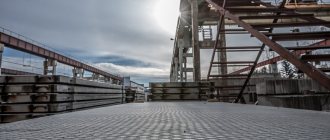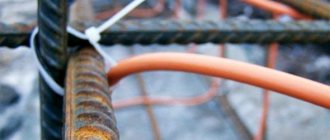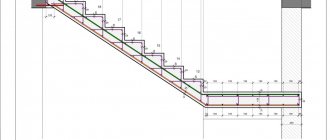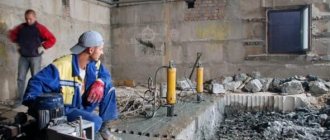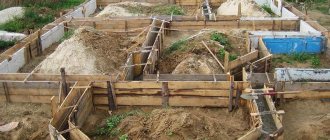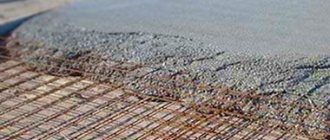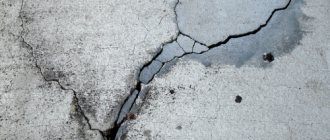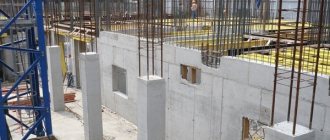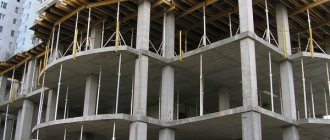Large brick or stone monolithic buildings have historically always been considered a sign of wealth and power, as they symbolized strength, reliability and permanence.
Modern technologies have allowed architects to cheaply and quickly build equally strong buildings using monolithic construction.
Thanks to this, high-rise residential complexes and office skyscrapers are being built around the world. And residential areas made of monolithic structures located in seismic zones can withstand earthquakes of up to 8 points without any damage.
What it is?
Reinforced concrete structures (RCS) are made of concrete containing:
- Portland cement;
- sand;
- reinforcement placed in the place of the product where it will be exposed to tensile forces. If the concrete is unreinforced, then on the contrary it experiences compressive stresses.
The increased strength of reinforced concrete products is explained by the fact that concrete itself resists compression very well up to 50 kg/cm2, while iron has high tensile strength from 1000 to 1200 kg/cm2 and even more.
There are two ways to produce reinforced concrete:
- The first is pouring liquid material into molds on a construction site, thereby obtaining monolithic concrete.
- The second is the precast concrete method, where parts are produced in a separate production facility and then transported to a construction site where assembly takes place.
Concrete mortar components:
- Portland cement;
- coarse aggregates such as crushed stone, fine aggregates such as sand, and water.
In the mixture, water chemically combines with cement, forming a plastic structure that binds the components together.
The upper limit of strength of a concrete solution is determined by the strength characteristics of the stone used in the aggregate. The structure of the binder solution is formed slowly, and the product reaches its design strength within 4 weeks after pouring the mixture.
There is a gap of one month between the time the cast-in-situ concrete is poured and the time it can bear the load, which significantly delays the progress of construction.
Advantages and disadvantages
Pros:
- the ability to build structures of any configuration;
- the thickness of the floors is less than standard reinforced concrete slabs;
- no seams, tight surface;
- creation of large floors and spans;
- cheap construction;
- there are no restrictions on the height of the building;
- construction of various types of objects.
Minuses:
- in harsh climates it is necessary to use additives, otherwise aggressive weather will render the structure unusable;
- The water in the mixture freezes and expands at low temperatures, eventually breaking the integrity of the finished structure.
To solve problems you should:
- use modifiers that speed up the drying of concrete in cold weather;
- create conditions for gradual hardening by heating the formwork system before pouring;
- heat building materials in production and deliver them to the site in special tanks.
Such measures improve the characteristics of concrete, but increase the final cost of construction. For this reason, it is recommended to build the facility in the summer.
Scope of application
The first monolithic house structure was erected in 1908 by Thomas Edison, after which such houses began to be built everywhere.
Today, multi-storey residential and public buildings are constructed using permanent formwork, which subsequently acts as a protective layer. Monolithic structures are suitable for all types of basement construction.
When and where is it prohibited to build concrete walls?
Monolithic construction has virtually no restrictions; the method is applicable to both high-rise buildings and small individual buildings. The only prohibition exists for the design of frameless monolithic buildings over 25 floors on normal soils, in non-seismic areas, from climatic zones 2 to 4.
A cold climate can be an obstacle to monolithic construction, since when the temperature reaches 5 C, the concrete solution needs to be heated or frost-resistant components must be included in it, which significantly increases the cost of construction and does not guarantee the high-quality formation of a monolithic structure.
In addition, concrete must be poured continuously and evenly throughout the entire formwork area to minimize the number of seams and obtain excellent structural strength characteristics. Concrete compaction must be done efficiently, which can only be achieved using special equipment.
Requirements according to GOSTs and SNiPs
Concreting of monolithic wall structures is strictly regulated by state urban planning standards. The basic one is SNiP 3.03.01-87.
The requirements for monolithic structures are detailed in each building construction project, on the basis of which a project for the production of monolithic works is developed.
It provides:
- stages of work preparation;
- installation of formwork;
- filling;
- control and care until the solution hardens and compliance with safety regulations at each production stage.
The standard establishes the following violations that should not be present on the surfaces of a monolithic structure:
- Areas with uncompacted concrete are prohibited;
- structures with exposed reinforcement are prohibited, except for its technological outlets;
- on concrete of classes: A/B/C there should be no oil stains or rusty stains;
- On the walls, only shrinkage cracks of no more than 0.1 mm for grades A, and 0.2 mm for grades B/V/G are allowed.
Brand and material characteristics
Brands of concrete differ in the content of components, their varieties and proportions. to the solution , which can improve many technical parameters of the design:
- frost resistance (F);
- moisture resistance (W);
- plasticity (P) .
The required class of building concrete by grade and its distinctive characteristics are established taking into account the standards, requirements of SNIP, technical conditions and the project for the building under construction with the required parameters of monolithic structures.
An essential characteristic of concrete is its maximum weight of one cubic meter of solution; standards require that this figure not exceed 1500 kg/m3.
Today on the Russian construction markets there is material with various characteristics of grades from M100 to M500 . The numbers that are indicated in the marking of the solution, for example, M100, show the average indicator of ultimate compressive strength, calculated in kgf/cm2.
It determines the resistance of monolithic products to all kinds of mechanical overloads, humidity and temperature, and also affects the final cost of the object.
How to make the right choice?
When purchasing a specific brand of concrete solution, they are guided by the project for building a house. If there is no project for a simple object, then the choice is entrusted to experienced builders, based on practice.
Application of concrete mix grades:
M100/B7.5 is not used in complex, critical work; it is usually used as an unloaded layer, which is a preparatory layer for monolithic load-bearing structures to ensure their strength characteristics.- M150/B12.5 acts as a preparatory layer for pouring reinforced concrete slabs.
- M200/B15 is the most frequently purchased modification; it has a wide range of use from foundations to flights of stairs, but can only be used on objects located on stable soils with a deep groundwater level.
- M250/B20 - production of monolithic foundations.
- M300/B22 is a universal material, since it works equally well for monolithic and strip foundations, and has an optimal cost-quality ratio.
- M350/B25 - the main purpose is pouring foundations and reinforced concrete monolithic wall structures.
- M400/B30 - the main purpose is transverse beams, plinths, retaining walls, monolithic objects.
- M450/B35 is used for bridge construction and subway construction.
Features of reinforcement depending on the type of foundation
When laying the foundation of a house, it is very important to follow the rules for reinforcing monolithic reinforced concrete structures. This will avoid many defects and guarantee a long service life of the object. According to the design of reinforced concrete monolithic structures, three types of foundations are distinguished.
Slab foundation
When reinforcing it, corrugated rod reinforcement is used. The thickness of a reinforced concrete monolithic structure (foundation slab) depends on the number of floors and the material used in construction. The standard figure is 15-30 centimeters.
Important! If the mass of the building is small, then in a reinforced concrete monolithic structure it is allowed to use a mesh with a cross-section of rods from 6 to 10 centimeters.
High-quality reinforcement of a slab foundation must have two layers. The lower and upper grilles are connected by supports. They form a gap of the required size.
The main difference between professional reinforcement of reinforced concrete monolithic structures is the complete concealment of all elements of the steel frame. At the same time, in a slab foundation, the reinforcement is not welded together, but is knitted together using wire.
Strip foundation
The structure of this reinforced concrete monolithic structure consists of a lattice, which is placed in the upper part and takes on all the loads associated with tension.
It is highly not recommended to weld frame elements - this will reduce its strength. In this case, the layer of concrete separating the steel elements and the soil must be at least five centimeters. This will protect the metal from corrosion.
In a reinforced concrete monolithic structure, it is very important to maintain the correct distance between the longitudinal rods. The limit is 400 millimeters. Transverse elements are used when the height of the frame exceeds 150 mm.
The distance between adjacent rods in a reinforced concrete monolithic structure cannot exceed 25 millimeters. Corners and joints are further reinforced. This allows you to give the foundation greater strength.
Pile foundation
This technology is used when constructing a structure on heaving soils. The optimal distance from the grillage to the ground is 100-200 mm. The gap allows you to create an air cushion, which has a positive effect on the insulation of the entire house. In addition, the air cushion allows you to avoid the formation of dampness on the first floor.
When creating piles, concrete grade M300 and higher is used. Wells are pre-drilled into which roofing material is inserted. It also serves as formwork. A reinforcement frame is lowered inside each hole.
The frame design consists of longitudinal corrugated reinforcement. The cross-section of the rods is from 12 to 14 mm. Fastening is carried out using wire. The minimum pile diameter is 250 mm.
Walls and ceilings
These elements also require special reinforcement rules. In principle, they are similar to the norms for creating foundations, but there are some differences:
- The minimum longitudinal diameter of the reinforcement in the wall is 8 mm, the maximum length step is 20 centimeters, the transverse diameter is 35 cm. The cross-section of the transverse reinforcement is at least 25% of the longitudinal cross-section.
- Floors. The diameter of the reinforcement is determined by the design loads. The minimum value is eight millimeters. The distance between the rods is no more than 20 mm.
- When creating both walls and floors, the use of a grid is allowed.
Reinforcement standards for walls and floors differ due to the different degrees of loads experienced by these reinforced concrete monolithic structures.
Technology of pouring concrete walls
Monolithic reinforced concrete structures are produced using the following methods: pouring concrete into formwork on site and industrial production of standard concrete products. Monolithic wall structures have increased seismic resistance and wear resistance.
The installation process is complex and is based on 3 stages:
- Assembling a metal reinforcement frame;
- formwork work;
- supplying concrete to the formwork.
To synthesize monolithic wall structures with each other and with the foundation, embedded parts in the form of reinforcement or wire are installed in them, which are a continuation of the reinforced base. The reinforcement is connected using annealed wire.
The formwork is erected from wooden or duralumin panels, which are dismantled after the concrete solution has firmly hardened. The panels are installed in such a way that they do not touch the reinforcement frame of the monolithic structure.
The formwork is set using laser levels.
Recently, in new high-rise construction, permanent polymer plastic formwork has begun to be used , which subsequently serves as insulation.
After the formwork is installed, concrete begins to be poured. The process is carried out in strict accordance with technology to ensure the solidity of the wall.
Each fresh portion of the solution is poured onto the previous one, which should not yet harden. Concrete is poured from the corners and gradually moved to the center of the formwork. After the monolithic wall has completely hardened, it is covered with a heat-protective layer and finishing plaster is applied.
A detailed article about pouring monolithic walls is here.
Retaining
Quite often, when building a house, on a site with difficult terrain, it is necessary to install powerful retaining structures to ensure the immobility of the soil.
This task is best accomplished by monolithic reinforced concrete structures, which in practice have proven to be reliable, durable, and capable of holding a large volume of soil.
To do this, the retaining structure must have the widest and strongest foundation possible. For it, you will need to dig a trench corresponding to the dimensions of the protective structure being erected, and with a depth in the ratio of 1 m of height - 0.45 m of depth. Crushed stone, reinforcement, pipes for drainage are laid in it and formwork is erected.
The pouring option is traditional, the main thing is to pour the solution evenly at one time and let it sit for at least 2 days until it hardens completely. Afterwards, the formwork is dismantled and waterproofing is applied to the reinforced concrete part of the surface that will be in contact with the ground.
It is also necessary to ensure efficient drainage, for which geotextiles are laid on installed plastic pipes. Next, backfill the retaining wall using sand and crushed stone.
Full information about the features of a monolithic retaining wall is here.
TECHNOLOGY OF PROCESSES FOR CONSTRUCTING STRUCTURES FROM MONOLITHIC CONCRETE AND REINFORCED CONCRETE
Along with increasing the production of building structures and fully prefabricated products, the construction of buildings and structures made of monolithic reinforced concrete is being further developed.
Industrial monolithic housing construction opens up wide opportunities for improving the quality and durability of housing, the expressiveness of the architecture of individual buildings and urban complexes. This method of construction requires less material and financial costs for its development and allows you to quickly increase the volume of housing construction, especially in areas with an undeveloped material and technical base. In comparison with panel housing construction, on average, the costs of creating a production base are reduced by 40%, metal consumption by 20%, and energy resource consumption by 30%.
In view of all these advantages of buildings made of monolithic and prefabricated reinforced concrete, the structures and methods of their construction deserve the closest study by future civil engineers.
Concrete work is work performed during the construction of monolithic concrete and reinforced concrete structures of buildings and structures made of cement concrete. Concrete work includes preparing a concrete mixture, delivering it to the construction site, supplying, distributing and compacting the mixture in a form (formwork), caring for hardening concrete, quality control of concrete work (testing samples for strength, water resistance, frost resistance, etc.). The concrete mixture is usually prepared in concrete plants or in mobile mixing plants.
Monolithic structures are concrete and reinforced concrete structures, the concreting of which is carried out directly at the site of their design position.
Formwork technology is a method of producing formwork, depending on the type of formwork used, the nature of monolithic structures and the technology of their construction.
Installation of formwork – assembly and installation of formwork and its elements into working position.
Stripping is the dismantling of formwork, carried out after the concrete of the concreted structure has reached strength allowing removal of the formwork.
Depending on the nature of the concreted structure and the design features of the formwork, additional requirements may be placed on stripping. Thus, when constructing monolithic foundations in solid removable block forms, the removal of the forms may be preceded by their “tearing down” using jacks; complete stripping of the floors of multi-storey brick buildings should be carried out only when the concrete of the underlying floors reaches the design strength; stripping of spatial structures should be done smoothly, without distortions.
Unwinding is a smooth and uniform lowering of supporting scaffolding. Unwinding precedes the removal of the load-bearing formwork.
The circle is a horizontal beam that combines the panels of the sliding formwork and takes the pressure of the concrete mixture.
Formwork is a structure that is a form for laying and curing concrete mixture; consists of form-building, load-bearing, supporting, connecting, technological and other elements and provides the design characteristics of monolithic structures.
Concreting block is a structure or part of it prepared for laying concrete mixture with installed formwork and mounted reinforcement.
Single-use formwork is formwork that is used once, for example, permanently, or in conditions of unique, non-repeatable structures.
Permanent formwork is formwork that, after concreting the main structure, is not removed, but remains in its body and works together with it; can be used as a waterproofing, insulating, decorative or facing layer of a structure.
Inventory formwork is reusable formwork.
Formwork turnover – repeated use of formwork without any additional repair work (the higher the formwork turnover, the lower its cost per unit volume of finished product).
Unified formwork (universal) - formwork consisting of inventory panels of various sizes with inventory supporting devices and fasteners. The dimensions of its main panels are, as a rule, subordinated to one modular size (300 mm in width and 100 mm in height).
Pneumatic formwork is formwork consisting of a flexible, airtight form-building shell made in accordance with the type of structure or structure being erected, supporting and load-bearing elements. In the working position it is supported by excess air pressure and is used for concreting thin-walled structures and curved structures.
Thermoactive (heating) formwork is any formwork system with heating elements installed on it to heat up the concrete. This formwork is intended for concreting monolithic structures in conditions of low ambient temperatures (from + 5°C), as well as for accelerating the hardening of concrete, both in summer and winter conditions.
Climbing formwork is formwork used for the construction of structures of great height, constant and changing cross-sectional geometry (pipes, cooling towers, bridge supports, etc.). It consists of panels that are separated from the concrete surface during lifting, as well as supporting, fastening, technological elements and devices.
Collapsible small-panel formwork is a structure consisting of small-sized formwork panels (up to 2 m² in area), supporting, connecting and installation elements weighing up to 50 kg (allowing manual installation), from which formwork can be assembled for concreting any structures, both horizontal and and vertical, including arrays, foundations, walls, partitions, columns, beams, floor slabs and coverings (Fig. 24).
Rice. 24. Small-sized formwork panels:
a – wooden on stitched strips; b – wooden box-type with a plywood deck; c – combined (frame – made of metal, deck – made of sheet plastic); d – steel; 1 – deck; 2 – stitching strips; 3 – stiffeners; 4 – holes for connecting shields;
5 – frame from corners
Large-panel collapsible formwork is a structure consisting of large-sized panels, supporting, connecting and installation elements weighing more than 50 kg. Their installation and dismantling is carried out only with the help of lifting mechanisms. This formwork is intended for the construction of large-sized and massive structures.
Block formwork is a spatial structure assembled from steel panels on detachable or hinged fastenings (formwork blocks) or welding (block - forms). It is used for the construction of free-standing foundations and fragments of large-sized structures (Fig. 25).
Rice. 25. Block formwork:
1 – mounting loops; 2 – shape of the column; 3 – bracket for supporting the jacks; 4 – step shape
Volume-adjustable formwork is used for the simultaneous construction of walls and floors of buildings. It consists of L- and U-shaped blocks-sections. The design allows the sections to slide inward. The sections are connected to each other along their length, forming several parallel rows with distances between blocks equal to the thickness of the walls. This allows, after installing the formwork and laying the reinforcement cages, to simultaneously concrete the walls and adjacent sections of the floors (Fig. 26).
Sliding formwork is formwork, the structure of which is moved vertically by jacks as the monolithic structure is being concreted and which consists of panels, jacking frames, jacking rods, lifting mechanisms and technological elements (working floor, scaffolding). They are used in the construction of vertical structures of buildings and structures of great height. The panels of such formwork have a height of 1.1-1.2 m and cover the concrete structure along the outer and inner contours (Fig. 27).
Rice. 26. Volume-adjustable formwork:
1 – formwork of lighthouses; 2 – central insert; 3 – L-shaped shield; 4 – stripping screw; 5 – hinged stripping mechanism; 6 – adjustable strut; 7 – rollers; 8 – screw jack; 9 – scaffolding for end walls; 10 – end wall shield
Reinforcement is the strengthening of a material or structure with another material. It is used in the manufacture of reinforced concrete and stone structures, glass products, plastics, ceramics, gypsum, etc. Fiber composite materials reinforced with high-strength continuous fibers have become widespread in technology.
Reinforcement work – work on preparing, knitting and laying reinforcement.
Reinforcement - steel rods, rolled profiles and wires located in concrete to work together with it.
The working reinforcement absorbs the work loads that arise during the operation of the structure.
Distribution reinforcement is used to distribute forces between working reinforcement, secure rods in the frame and ensure their collaboration, as well as to absorb transverse forces and prevent oblique cracks in concrete.
Mounting reinforcement ensures the design position of individual rods when assembling flat and spatial frames.
Clamps are used to connect individual working and mounting rods into a finished spatial frame.
The spatial frame consists of flat frames connected, if necessary, by mounting rods. Used for reinforcing columns, beams, crossbars, foundations (Fig. 28).
A flat frame consists of two, three, four or more longitudinal rods connected by transverse, inclined or continuous (snake) rods. Used for reinforcing beams, purlins, crossbars and other linear structures (Fig. 35).
Rice. 27. Sliding formwork
1 – visor; 2- jack; 3 – jacking frame; 4 – working floor;
5 – jacking rod; 6– formwork panels; 7.8 – internal and external suspended scaffolding
The mesh consists of mutually intersecting rods, connected at the intersection points mainly by welding (Fig. 29).
An embedded part is a structural element made of reinforcement rods and flat rolled steel. Used for welded connections of prefabricated reinforced concrete structures during installation (Fig. 30).
Protective layer - the distance between the outer surfaces of the reinforcement and concrete of the structure. It protects the fittings from the corrosive effects of the external environment. The layer thickness must be at least 10 mm (depending on the type of structure).
Protective layer clamps are special stops or elongated transverse rods, as well as concrete, plastic or metal clamps that are placed on reinforcing bars or tied to them (Fig. 31).
Rice. 28. Spatial frame
| V |
| b |
| A |
Rice. 29. Examples of reinforcing elements:
a – flat mesh; b, c – flat frames
Rice. 30. Embedded part
Contact welding of reinforcement has the following main types.
Contact spot welding
used to connect intersecting rods in meshes and frames. The essence of this welding is that two (or more) rods at their intersection are clamped between the electrodes of the welding machine. When a current is passed, the metal of the rods in the place to be welded, under the influence of the generated heat, becomes red-hot, softens, and under the influence of a compressive force, the rods are firmly connected to each other.
Contact butt welding
It is advisable when it is necessary to increase the length of the rods, as well as to splice trim and rods.
| A |
| G |
| d |
| e |
| V |
Rice. 31. Methods for providing a protective layer of reinforcement:
a – in beams and ribs of slabs using stops; b – in beams using elongated rods; c – concrete lining with twisted wire; d – concrete plug with a spring bracket; d – elastic plastic retainer; e – stamped metal stands.
Electric arc welding of fittings is based on the principle of the formation of an electric arc between the part being welded and the electrode, under the influence of which the metal of the electrode and the fittings simultaneously melts. After the melt cools, a weld is formed. Electric arc welding can be performed using either alternating or direct current.
Bathtub welding is based on the melting of electrodes and mating rods in a semi-closed form called a bathtub. The molds are stamped steel or copper. Joint rods are placed in them with a gap, between which one or a comb of electrodes is inserted. As a result of the occurrence of a voltaic arc, the metal melts and the melt fills the bath. This method is used to connect rods with a diameter of more than 20 mm.
Concrete mixture is a rationally composed and thoroughly mixed mixture of concrete components before the hardening and setting processes begin. Consists of water, binder and grains of coarse and fine aggregate.
Formless concreting – concreting when laying the concrete mixture “in space”, for example, when installing bored piles, strip foundations, shotcrete, etc.
Shotcreting of concrete is a technological process of applying one or several layers of cement-sand mortar (shotcrete) or concrete mixture (sprayed concrete) to the surface of a structure or formwork in a stream of compressed air. The composition of shotcrete includes cement and sand; shot concrete, in addition to cement and sand, includes coarse aggregate no more than 25 mm in size. Shotcrete is applied with a cement gun, and shotcrete is applied with a concrete injection machine.
The mobility of a concrete mixture is the ability of the mixture to spread under the influence of its own mass. Characterized by the measurable settlement of a cone molded from a concrete mixture. It is calculated as the arithmetic mean of two determinations made from one concrete mixture sample (Fig. 32).
Rice. 32. Determination of the workability of a concrete mixture:
a – device (cone) for determining the mobility of a concrete mixture: 1 – rigid mixture; 2 – mobile mixture; 3 – cone settlement; b – device for determining the hardness of a concrete mixture: 4 – test diagram.
The hardness of a concrete mixture is an indicator of the dynamic viscosity of a concrete mixture. It is characterized by the time (seconds) of vibration necessary to level and compact the molded cone of concrete mixture in a device for determining stiffness.
Workability of a concrete mixture is the ability to fill a mold using a given compaction method while maintaining homogeneity. Three indicators are used for assessment: mobility, rigidity, connectivity.
Plasticizing chemical additives are additives that increase the mobility of the concrete mixture (sulfite-yeast mash).
Antifreeze chemical additives are additives that reduce the freezing point of the liquid phase of concrete (sodium nitrite, nitrite-nitrate-calcium chloride).
Air-entraining chemical additives are additives that increase the porosity of the concrete mixture (mylonaft, asidol).
Ultrasonic pulse method for testing the strength of concrete is a non-destructive physical method for testing the strength of concrete. In this case, special ultrasonic devices are used, with the help of which the speed of passage of ultrasound through the concrete of the structure is determined. The compressive strength of concrete in a structure is determined from the graduated curves of the ultrasonic velocity and the compressive strength of concrete.
A working seam is a joint plane between hardened and freshly laid concrete, formed as a result of a break in concreting. It is formed when subsequent layers of concrete mixture are laid on fully hardened previous layers. This usually occurs when there are breaks in concreting for more than 7 hours. Working seams are a weak point, so they should be placed in sections where the joints of old and new concrete cannot adversely affect the strength of the structure.
Regional factories for the preparation of concrete mixtures supply construction sites located at a distance not exceeding the technologically accessible distance of road transport with ready-made mixtures. The district plant usually serves construction sites located within a radius of 25 - 30 km.
On-site concrete mixing plants usually serve one large construction site for 5 to 6 years. Such plants are made of prefabricated block construction, which allows them to be relocated in 20–30 days.
Construction concrete mixing plants serve one construction site or a separate facility with a monthly demand for ready-mixed concrete of up to 1.5 thousand m3.
A tub is a container that is used in construction for transporting and supplying concrete and mortar mixtures to the installation site. By design, the tubs can be rotary or fixed; they are often equipped with vibrators to improve the unloading of mixtures, as well as electric heaters for preliminary electrical heating (heating) of mixtures.
A concrete mix bunker is a special device designed to receive concrete mix from dump trucks and transport it by cranes to the concreting site. Structurally, the bunkers are made rotating and non-rotating.
Concrete placing machine is a portal ground self-propelled machine designed for dispensing and laying concrete mixture when forming reinforced concrete flat products for the construction of buildings and structures from prefabricated elements. Concrete placing machines can be single-hopper with or without a smoothing device, double-hopper and treble-bin with a smoothing device.
Concrete pump is a machine for pumping concrete mixture. Allows you to deliver concrete mixture with a high degree of intensity (from 5 to 80 m3/h or more) to a distance of up to 400 m horizontally and up to 100 m or more vertically. To increase the mobility of concrete pumps, they can be installed on vehicle chassis or trailers.
Pneumatic blower is a device for supplying concrete mixture through pipes under the influence of compressed air (air consumption - up to 30 m³ per 1 m³ of concrete). It is possible to supply rigid concrete mixtures (cone slump 3 - 4 cm) to a height of up to 50 m or horizontally to 250 m.
A cement truck is a specialized vehicle for transporting cement in a sealed tank from base warehouses and cement plants with pneumatic loading from silo-type warehouses and bunkers and pneumatic self-unloading into consumer warehouses.
A concrete truck is a machine for transporting concrete mixture. The body has a trough-shaped shape. The smooth connection of the sides with the bottom eliminates concrete sticking in the corners. A fairly large tilt angle of the body (80 degrees) and the presence of a vibration exciter allows you to quickly unload the mixture; the lid protects it from water loss and cooling
A concrete mixer truck is a concrete mixing drum mounted on a car chassis or on a semi-trailer towed by a truck tractor. It can transport dry and ready-mixed concrete. The technological advantages of concrete mixer trucks include the ability to deliver the mixture over long distances without compromising its quality, as well as the presence of adjustable batch unloading.
Concrete finishing machine is a machine for finishing the surface of freshly laid concrete pavement.
Vacuuming is a technological method that allows you to extract about 10-25% of the mixing water from the laid concrete mixture with its additional compaction. Vacuuming is carried out either from above (vacuum shields, vacuum mats) or from the side surfaces (vacuum formwork).
Concrete compaction by tamping is a compaction method performed with manual and pneumatic tampers when laying very rigid concrete mixtures in lightly reinforced structures, as well as in the case when vibrators cannot be used due to the negative impact of vibration on nearby equipment, etc. The mixtures are compacted in layers with a thickness of 10 – 15 cm.
Compacting concrete by bayoneting is a compaction method performed manually using screws. Due to low productivity and labor intensity, this method is used in exceptional cases: when concreting thin-walled and densely reinforced structures and using highly fluid mixtures.
Concrete compaction by vibration is a compaction method in which a concrete mixture, which is a multicomponent conglomerate, is subjected to vibration. During the period of vibration, it acquires the properties of a heavy liquid with significant fluidity. In this case, the mixture well fills the formwork form and the space between the reinforcing bars. At the same time, when the viscosity of the mixture decreases as a result of vibration, its particles, under the influence of gravitational forces, tend to take the most stable position in relation to each other. This leads to their mutual sealing, i.e. to the most dense arrangement in the form. At the same time, increased pressure is created in the vibration zone, as a result of which air is intensively displaced from the mixture. These interrelated processes provide concrete with a dense structure and good quality.
Deep (internal) vibrators are vibrators, the working part of which is immersed in a concrete mixture. They transmit vibrations through the body (Fig. 33).
Rice. 33. Deep vibrator (internal):
1 – body; 2 – rod
Site vibrators (surface) – vibrators installed on the concrete mixture to be compacted. They transmit vibrations through the working platform (Fig. 34).
Rice. 34. Area vibrator (surface):
1 – vibrator; 2 – platform
External vibrators are vibrators mounted on the formwork using a vice or other gripping device. They transmit vibrations through the formwork (Fig. 35).
Rice. 35. External vibrators:
1 – vibrator; 2 – formwork
Vibrating screed is a unit for vibrating compaction of concrete mixture and finishing the surface of laid concrete.
Winter concreting conditions are conditions under which the average daily outside air temperature drops to +5°C and drops below 0°C during the day.
The critical strength of concrete is the strength of concrete in % of the brand value, after reaching which concrete can be frozen without reducing its strength and other indicators in the process of subsequent hardening as a result of thawing.
Electric heating of concrete is a method of heat treatment of concrete in winter conditions, in which an alternating electric current is passed through the concrete as through an ohmic resistance, and heat is released in the concrete.
Plate electrodes belong to the category of surface electrodes and are plates made of roofing iron or steel, hung on the internal surface of the formwork adjacent to the concrete and connected to opposite phases of the network (1ph, 2ph). Using plate electrodes, lightly reinforced structures of regular shape and small sizes are heated (Fig. 36).
Rice. 36. Plate electrodes.
Strip electrodes are electrodes made from steel strips 20–50 mm wide, sewn onto the inner surface of the formwork adjacent to the concrete, and connected to opposite phases (Fig. 37.).
| b |
| A |
Rice. 37 Strip electrodes:
a – double-sided arrangement of electrodes; b – one-sided
Rod electrodes – electrodes made of round steel with a diameter of 6 – 12 mm. They are immersed in concrete after it is laid in the structure. For ease of connecting the electrodes to the electrical network, they should protrude 5–8 cm above the concrete surface.
Floating electrodes are reinforcing bars with a diameter of 6–12 mm, sunk into the surface of the heated concrete by 2–3 cm.
String electrodes are electrodes made of reinforcing steel with a diameter of 6-16 mm, used for heating structures whose length is many times greater than their cross-sectional dimensions.
Exothermic heat (exothermic heat release) is the heat released as a result of the physicochemical interaction of cement minerals and water (hydration reaction).
The thermos method is one of the methods for curing concrete in winter conditions, based on the principle of using the heat introduced into the concrete before laying it in the formwork, and the heat generated by the cement during the hardening process of the concrete. The total heat reserve must correspond to its losses when the structure cools (with appropriate insulation) until the concrete reaches the specified strength.
The Kashkarov hammer is used for non-destructive mechanical testing of concrete strength. To determine the compressive strength of concrete, place it with a ball on the concrete and strike the body of the standard hammer with a plumber's hammer. In this case, the ball is pressed with its lower part into the concrete, and with its upper part into the reference steel rod, leaving an imprint on both the concrete and the rod. After measuring the diameters of these indentations, their ratio is found and the compressive strength of the surface layers of concrete is determined using calibration curves.
Induction heating of concrete is a method of heat treatment of concrete based on the use of the magnetic component of an alternating electromagnetic field to heat steel due to the thermal effect of an electric current induced by electromagnetic induction. In reinforcement or steel formwork, the energy of an alternating electric field is converted into heat and transferred by thermal conductivity to concrete.
A greenhouse is a temporary structure, which is divided into volumetric and flat.
Volume
is a temporary room within which concrete structures are placed. Such greenhouses are built before the construction of the structure. Formwork, reinforcement and concrete work is carried out directly in it. Large greenhouses are heated with portable stoves, heaters or using tubular registers.
Flat
equipped with a removable steam jacket-box. Concreting is carried out in the open air, the laid concrete is covered with removable boxes. They contain heating devices, after turning them on, the necessary heat and humidity environment is created under the greenhouse.
Continuous concreting is a method used in the construction of massive hydraulic structures or structures. The combination of continuous transportation and laying of concrete mixture with its preparation in continuous plants makes it possible to organize continuous-flow concreting of structures. There are two methods of continuous transportation of concrete mixture: belt conveyors and concrete pumps.
Separate concreting is work performed during the construction of reinforced concrete tanks, foundations for equipment, monolithic pile foundations, as well as densely reinforced structures or in hard-to-reach places using the injection or vibration injection method.
Underwater concreting is laying a concrete mixture under water to prevent its erosion and removal of the binder from the mixture.
For concreting structures at shallow depths of up to 1.5 m, when the upper part of the structure must protrude above the water level, the tamping method, or concreting with an “island,” is used. In some cases, for small volumes of work, concrete mixture or dry concrete mixture is placed under water in bags in a dressing made of rare fabric.
The tamping method is an underwater concreting method in which work begins with the creation of a concrete island in one of the corners of the concrete structure. The island should rise above the water surface by at least 30 cm. The underwater slope of the island, from which compaction begins, should form an underwater angle of 35 - 45 o to the horizon. New portions of the concrete mixture are compacted into the island evenly and no closer than 20–30 cm from the water’s edge. The method is used at water depths of up to 1.5 m for the construction of large areas. In this case, the mixtures must be rigid (Fig. 38).
Rice. 38. Tamping the concrete mixture:
1 – fencing (formwork); 2 – weak layer of concrete;
3 – tamped concrete mixture.
The vertically moving pipe (VPT) method is a method of concreting a structure at a depth of up to 50 m, protected from running water, when high strength and solidity of an underwater structure is required. The concrete mixture is placed into a specially made formwork using a steel concrete pipe, equipped with a funnel on top for receiving the mixture, and a valve on the bottom, which opens at the moment of its supply. At the beginning of concreting, the pipe is lowered to the bottom with a minimum gap allowing free exit of the mixture. A wad made of burlap is inserted into the cavity of the pipe, and a concrete mixture is fed through the loading funnel, under the weight of which it falls to the base of the pipe and is forced out of it into the water. Concreting without lifting the pipe continues until the concrete mixture, having filled the entire space of the concrete block, rises above the end of the pipe. The block is concreted to a level exceeding the design mark by an amount equal to 2% of its height, but not less than 100 mm, followed by removal of the weak top layer (Fig. 39).
Rice. 39. Scheme of underwater concreting using a vertically moving pipe method: 1 – formwork; 2 – working floor; 3 – pipe links; 4 – fence; 5 – loading funnel; 6 – stand; 7 – concrete pipeline; 8 – floating crane
The rising mortar method is a method of underwater concreting, carried out using gravity and pressure methods.
With the non-pressure method
a shaft with lattice walls is inserted into the concreting block, and a steel pipe with a diameter of 38–100 mm is lowered to the entire depth of it. Rock fill is poured into the space between the linings, the voids of which are filled with a solution supplied through a pipe under the influence of gravity.
With the pressure method
filling pipes are installed without shafts in stone or crushed stone filler and cement mortar is pumped (injected) through them under pressure (Fig. 40).
Rice. 40. Scheme of underwater concreting using the ascending method
solution:
1 – stone and crushed stone filling; 2 – solution; 3 – tongue and groove fencing (formwork); 4 – fence; 5 – flooring; 6 – shaft;
7 – pipe; 8 – winch; 9 – water; 10 – sleeve; 11 – mortar pump
Concrete care is the process of creating the temperature and humidity conditions necessary for hardening the compacted concrete mixture and protecting the concrete from shocks, impacts, etc.
Heating formwork is a mold for casting concrete products (thermoactive) in winter at air temperatures down to minus 40°C. Heating formwork consists of steel formwork panels in which tubular electric heaters or a heating cable are installed.
Sealing of joints is the process of transforming the interface between two or more prefabricated reinforced concrete structures or their elements into a monolith. It is achieved by fastening the outlets of reinforcement or embedded parts and then filling the joint cavity with concrete mixture or mortar.
Advantages and disadvantages
The biggest advantage of reinforced concrete partitions is the complete solidity of the entire object , since all the elements that make up the structure of a reinforced concrete object: beams, columns, and slabs are firmly connected together, providing high resistance to vibrations and seismically active ground movements.
Also, the main advantages of monolithic reinforced concrete structures are considered to be their high fire safety; concrete not only does not burn, it also does not transmit temperature well, so fire does not have a dangerous effect on the reinforcement, as happens on conventional metal structures that melt and deform from high temperatures.
Also, the advantages of monolithic concrete and reinforced concrete partitions include the following indicators:
- Simplicity of design, the highest speed of construction, low transport costs, since there is no need to transport huge concrete products, they are prepared on site.
- A complex system for preserving an object during forced construction downtime is not required.
- You can create objects of almost any shape and significant height, the main thing is that the climatic conditions and soil characteristics allow it.
- Perfect tightness and high quality external surfaces.
- Low labor costs compared to brick or panel houses.
The main disadvantage of such walls is the high cost of construction. This is caused primarily by the cost of formwork and finishing materials. In addition, such wall construction is heavier than structures made from other materials, and installation requires a large amount of formwork work, which requires the use of more qualified labor.
